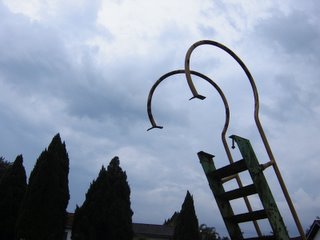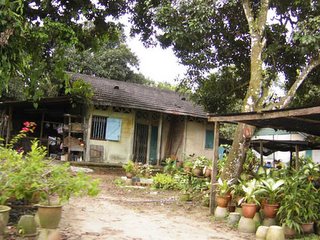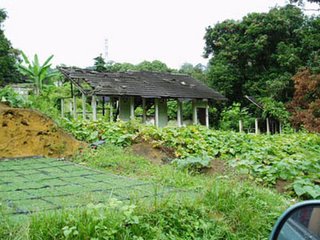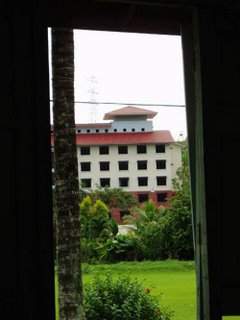Kustaville: That misty green bowl
 You're missing that Red Bull spring in your step lately. The city seems dreary. You're craving for a double-shot of Jiwa. How about trying a Leper’s Secret but nope, it’s not a drink.
You're missing that Red Bull spring in your step lately. The city seems dreary. You're craving for a double-shot of Jiwa. How about trying a Leper’s Secret but nope, it’s not a drink.
In a more forgotten part of Sungai Buloh, 3km off the lorry-worn grey asphalt of Jalan Kuala Selangor, away from the smog of nervous development and machine sounds and faux stones and faux smiles, the skinny road leads you through an emerald valley and into a vessel of calm.
Bring along an umbrella and pray for rain.
As the name suggests, the Sungai Buloh Leper Settlement was once a confined colony for lepers throughout the country. This compound, set up in 1930, replaced the Pulau Jerejak settlement in Penang, which closed after the British moved its Malaya nerve center to KL. Today, with leprosy under control, only a small enclave is used to house the remaining victims of the disease.
KL gardening maniacs know this place because of the dozens of nurseries fronting the narrow tree-lined streets. Aunties and uncles, Datuks and Tan Sris, boyfriends and girlfriends, they come here turning it into a kaleidoscopic petal bazaar especially during weekends and holidays. You pick your plants walking under majestic shady trees. No loud speeding lorries in the background to interrupt your stroll. How much sweeter can that be? What is lesser acknowledged, yet of prime importance in the Klang Valley, is the living, organic nature of the place which ties back directly to the colonial British articulations of space for the common people. In my view, this is heritage. Bonus issue – this is heritage hand-shaking with nature. No idiotic theme park, no self-conscious lamp-posts, no pretentious chengal pondoks.
What is lesser acknowledged, yet of prime importance in the Klang Valley, is the living, organic nature of the place which ties back directly to the colonial British articulations of space for the common people. In my view, this is heritage. Bonus issue – this is heritage hand-shaking with nature. No idiotic theme park, no self-conscious lamp-posts, no pretentious chengal pondoks.
Kustaville’s beauty is in its uncommon commonness. The compound is not a wonder by any architectural measure. Simple buildings, simple layout. Rather, it is a marvelous journal of continued human activity played out along the streets, the various buildings and the landscape. This could happen only because over the last few decades, development preferred to forage on other parts of the Klang Valley.
The area today exudes dignified warmth and thrives because of an on-going viable economy generated by the local nurseries going back a couple of generations. On the pretext of getting some plants, it has become a place to lepak, to have tea. Interestingly these nurseries were first introduced back in the days of the British by the hospital admin to help lepers be financially independent. After all, they weren’t handicapped in any sense.
That simple 'pocket-money economics' proposal turned out to be the gemstone in the ring of time. This continuity from colonial days to the present makes it a useful case study and reference on how a place matures without the forced will of a ‘theme’ or ‘concept’ which has often become the recipe for architecture and town-planning disasters in more recent memory. It also beckons fundamental questions such as why does this place feel good? Rather than fight age as seems the prevailing value of many newer buildings in the city, this place comes across as genuine. Rather than a shout, it chooses to whisper. And to whoever cares to listen for just a little, it speaks of this: Soul doesn’t have to cost an arm and a leg. That a community is more about thoughtful layout based on a sublime understanding of how people behave rather than shoving in a fancy clubhouse in a fancy-named condo. That the landscape matters, oh yes it matters. That hills are hills, and not to be levelled just because you can do it. And that rain in our part of the world is like a wonderful musical instrument as well as a visual feast when done right.
Rather than fight age as seems the prevailing value of many newer buildings in the city, this place comes across as genuine. Rather than a shout, it chooses to whisper. And to whoever cares to listen for just a little, it speaks of this: Soul doesn’t have to cost an arm and a leg. That a community is more about thoughtful layout based on a sublime understanding of how people behave rather than shoving in a fancy clubhouse in a fancy-named condo. That the landscape matters, oh yes it matters. That hills are hills, and not to be levelled just because you can do it. And that rain in our part of the world is like a wonderful musical instrument as well as a visual feast when done right.
Kustaville comprises a community core with a multipurpose hall, schools, churches, marketplaces, playgrounds, and clan houses laid out in the British tropical town-planning tradition of that era. Along the jungle-green hills are strings of twin cabins, each no larger than an average-sized bedroom with an outhouse. Honestly, the trails are so surreal you’d think you were in Hobbit land. These were where the victims of leprosy, deformed by the disease and branded with a stigma, would live and work on small plots of land.
Although many are still occupied (you even see Astro dishes mounted on the eaves of roofs), for the most part, the remaining cabins are in high degree of disrepair. Nature has reclaimed. A few buildings in the community core are also meeting that fate. In what was once a proud Scouts building, roof tiles are slowly crumbling and inside, a Strangling Fig tree has taken hold on one of the walls. The old markets have become lofts for sleeping dogs. And once-handsome and tall wooden doors have begun to fall off their hinges.
The rewards are still breathtaking: Go by in the morning, set yourself at the unmistakable Spot X, shiver in the chill and watch the mist rise from the valley below with the dew-heavy hills as backdrop. And you will know this – this is the tropics. Walk the compound the next time you’re in the neighborhood. Walk slowly. Walk into the abandoned hospital ward next to the Rumah Tikus, the ward with a commonsense basilica plan and exposed steel trusses. Feel the pregnancy of its space. If the clouds turn grey and swollen and finally spit their load, you’re in luck. From inside the cavernous room, behold the rain. Listen to its sound. And you will know this – this is the tropics.
Walk the compound the next time you’re in the neighborhood. Walk slowly. Walk into the abandoned hospital ward next to the Rumah Tikus, the ward with a commonsense basilica plan and exposed steel trusses. Feel the pregnancy of its space. If the clouds turn grey and swollen and finally spit their load, you’re in luck. From inside the cavernous room, behold the rain. Listen to its sound. And you will know this – this is the tropics.
And it is architecture such as this, simple and direct, which will root us to the land, wake up our senses to its light, and moisture, and sounds, and heat, and our Being. And this is one human pattern which coexisted genuinely – and can continue coexisting – without robbing the beauty of a place.
So taken in by the ambience, I called up JKR about the possibility of leasing an abandoned building. I thought the ward would make a wonderful studio. I was willing to foot in the bill for repairs. The reply was a flat ‘No’. The reason given was that it would disturb the peace. Peace. There cannot be peace when the gullies of development are already right at its borders. The signs are clear: Road-widening works are ongoing and fast approaching this area. Already a section of wooden shops have been demolished to make way for this new artery. Blocks of apartments have sprouted right behind the nurseries. The spanking new Sg Buloh Hospital is about completed just across the street from the old one. This youngest member is a huge complex. It is slick and booms across a brash confidence, why a heroism. Honestly, it doesn’t sync with Sg Buloh - its design would be better off in Cyberjaya. Where is the sensitivity, dude?
Peace. There cannot be peace when the gullies of development are already right at its borders. The signs are clear: Road-widening works are ongoing and fast approaching this area. Already a section of wooden shops have been demolished to make way for this new artery. Blocks of apartments have sprouted right behind the nurseries. The spanking new Sg Buloh Hospital is about completed just across the street from the old one. This youngest member is a huge complex. It is slick and booms across a brash confidence, why a heroism. Honestly, it doesn’t sync with Sg Buloh - its design would be better off in Cyberjaya. Where is the sensitivity, dude?
These signs speak one thing to me: The days of this community and its social and economic fabric are numbered. We’ve seen this too many times before. Swaths of Melaka’s historic core have been irrevocably altered. Penang, too, faces that threat. Important historical tracts in KL have been obliterated such as Subang Airport’s Terminal One, Malaysia’s first international airport. All done without thoughtful and compassionate planning. All done without caring about the public's views.
Hence the call: Preserve this. Preserve this but not mummify it. As scholar/architect Chen Voon Fee said: “Preservation isn’t merely about keeping the physical artifact, it is about maintaining the genre of activity that occupies that space.” Preserve it as centuries-old cities in Europe have preserved their historic cores with continued inhabitation.
As Malaysia matures, it will be communities such as this that will provide our bearing. And it will be places such as this that will remind us that we are a people of the tropics. That we are umbrella-bearers and we know rain can dance. And double-shot Jiwa can still be had for free.
2 comments:
I stroll from blog to blog sometimes, but you have substance you have intergrity. You have heart, mind and soul. Salute your courage and sentiment.
anonymous: awww, you make me blush
Post a Comment